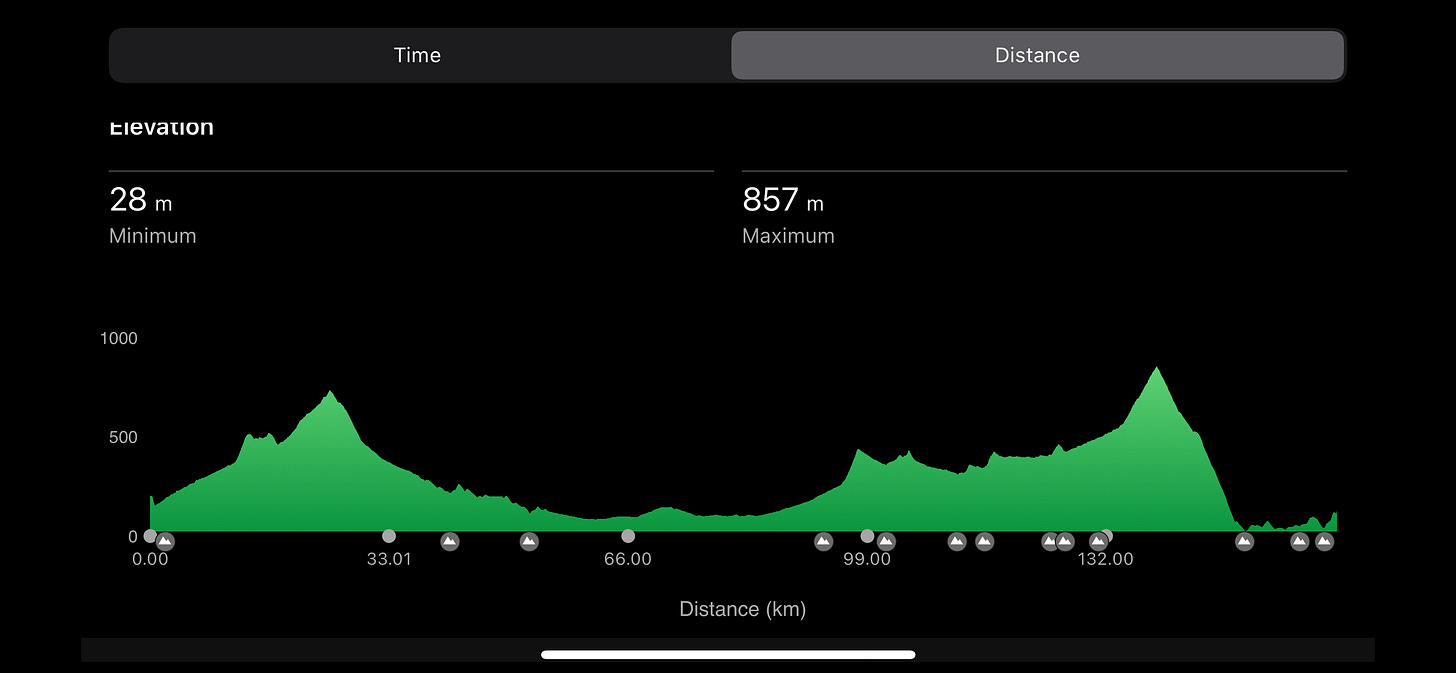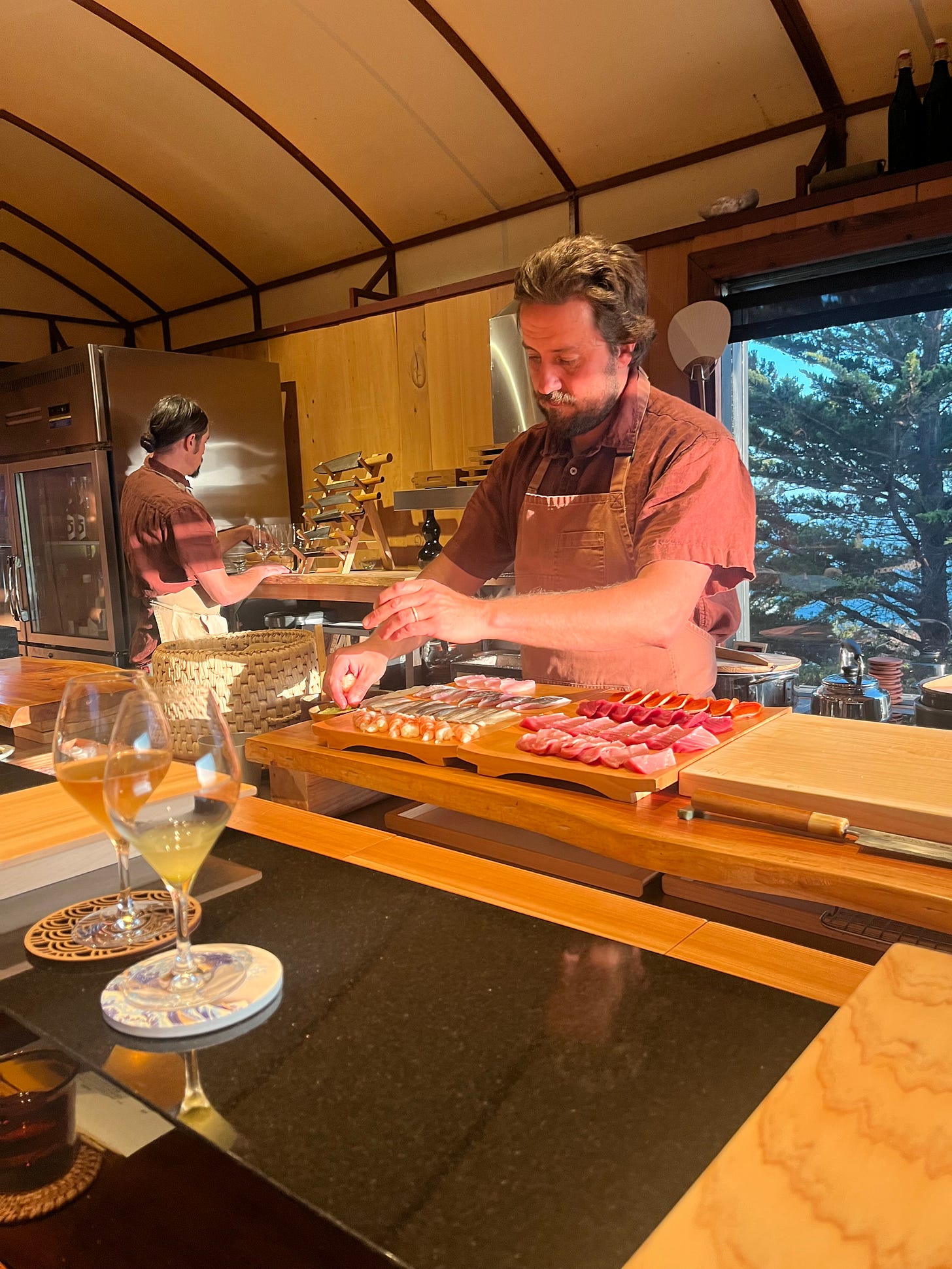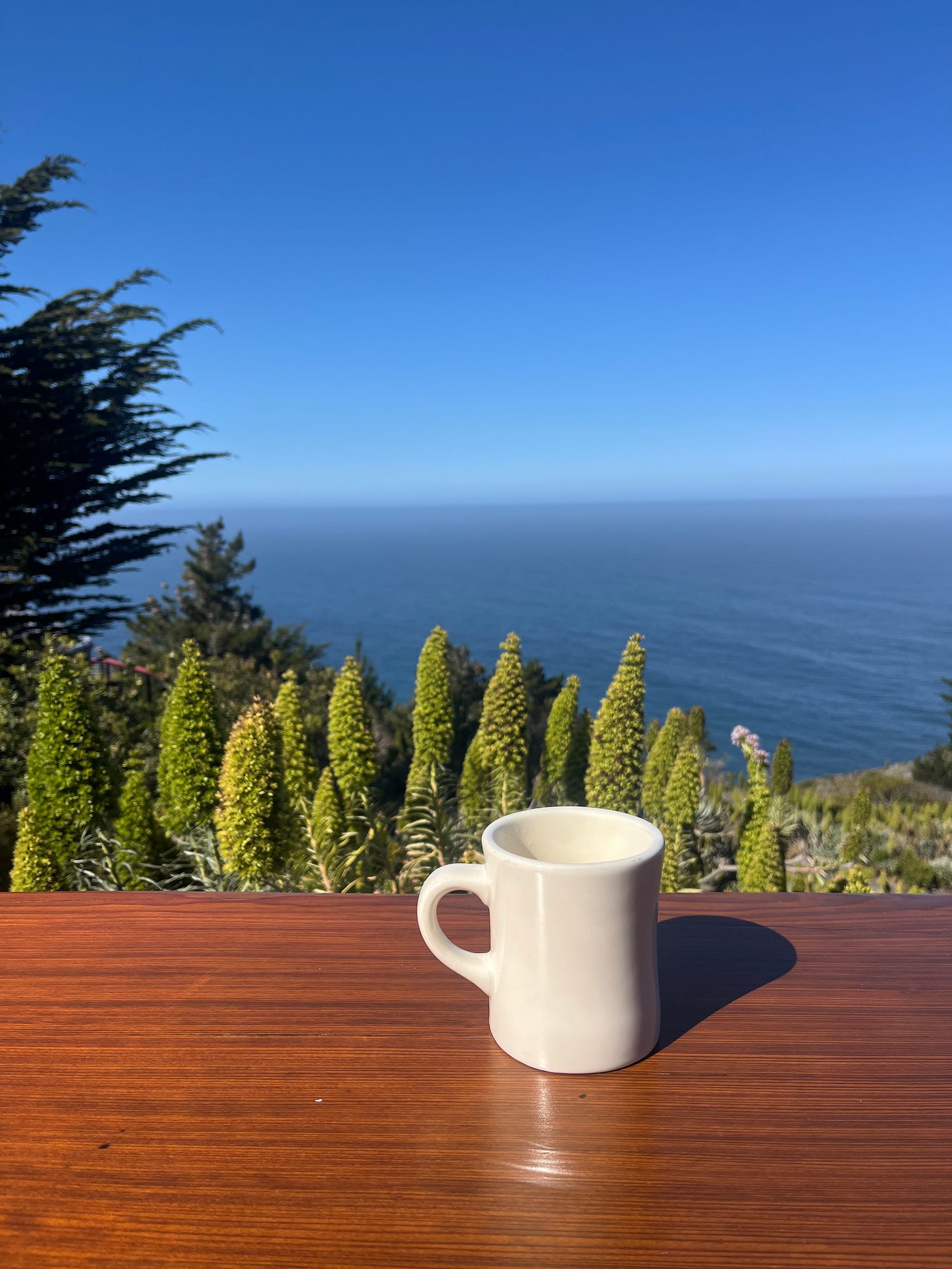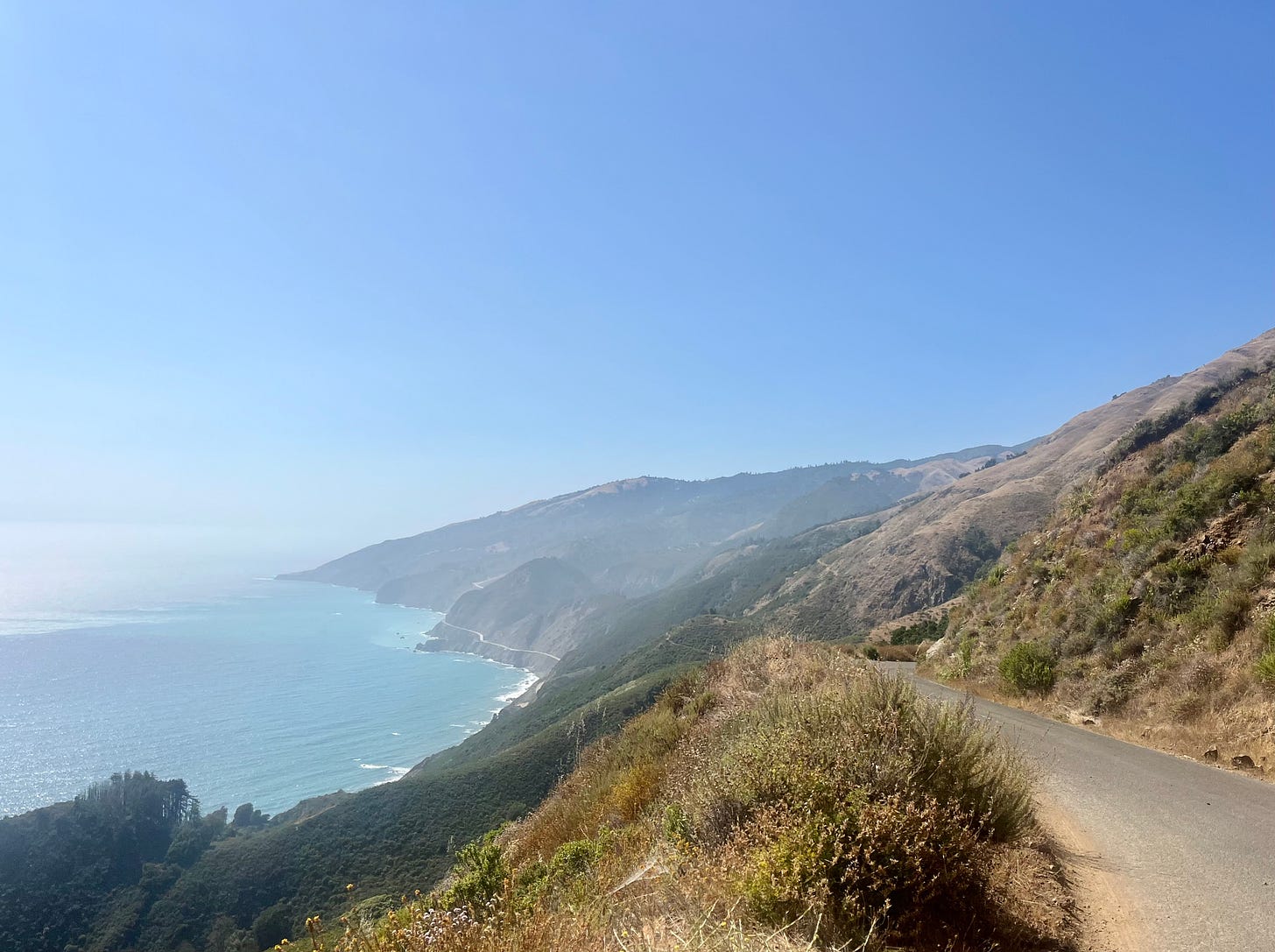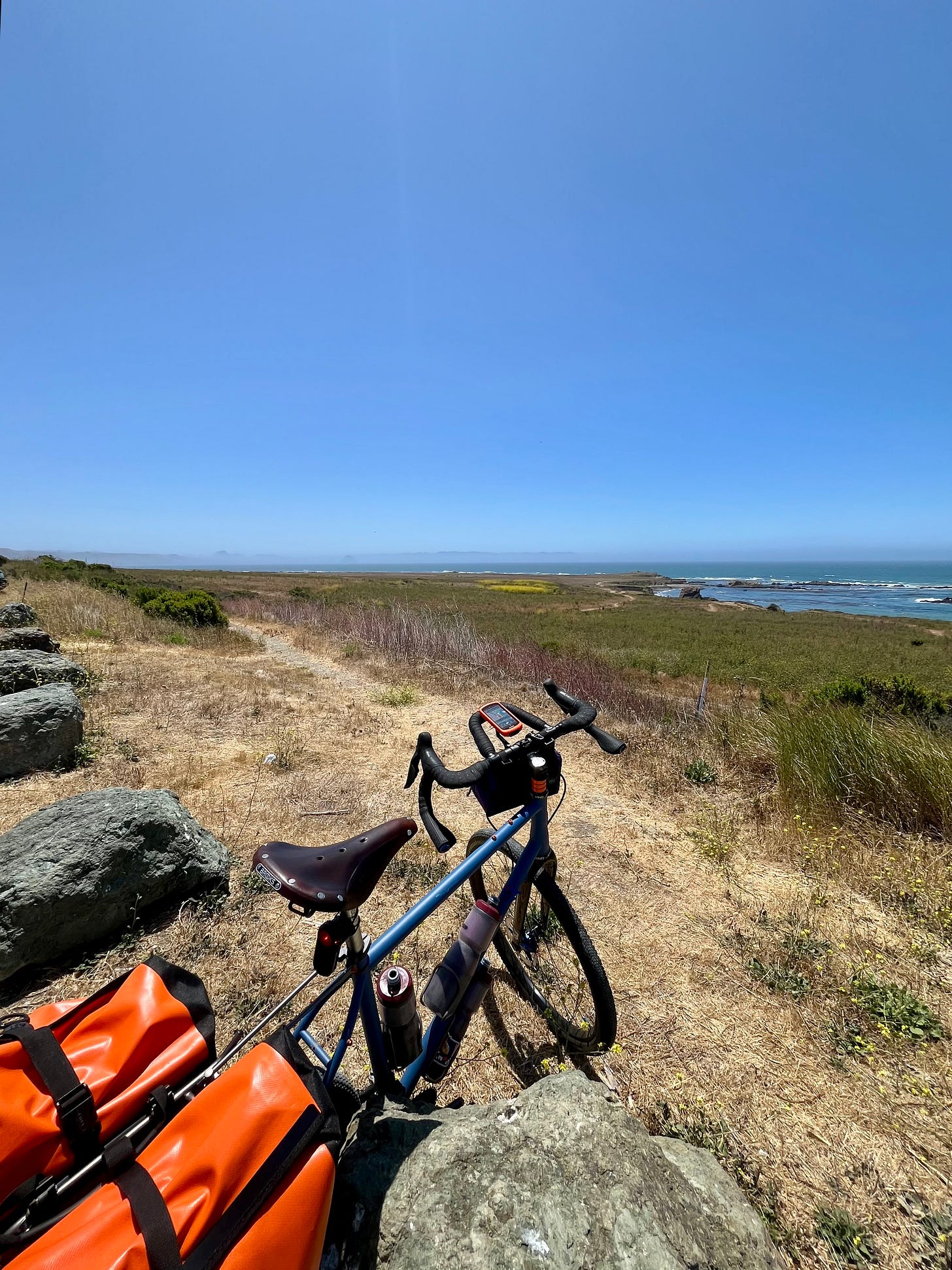California Coast Pt 2
02/02 | Stanford to Santa Barbara
You can’t make an omelet without breaking a few eggs.
You can’t get stronger without ever riding into the wind or climbing hills.
You can’t do entrepreneurship without failing, and failing fast.
Dave, or DTL, the fourth master I meet in Santa Barbara is an alumni from my program at Stanford. He is in the second half of his career, after achieving enough success, has the type of generous spirit that cares more about teaching others how to win.
We meet for a coffee at 10 am in downtown Santa Barbara, before my 12:20 train back north. And chat for two hours.
“You need to find a problem, that the cost of not solving is very, very high.” He says to me about starting a business, that is pre product and pre everything.
“Yeah but how do I that? Can you teach me?”
Can I learn how to be the best listener in the world? Can I learn how to fail?
Failure isn’t the risk here— it’s the method.
“I have half a good idea every month.” I tell DTL.
“20-30 interviews.” He says -“That’s what I’ve found to be around the sweet spot to figure out if you’ve got something.”
“Open yourself up — the customer conversations are so crucial…everything is going to flow from that...”
Idea. Interview. Prototype. Listen. Repeat
Think. Talk. Build. Fail. Again.
Ideate. Test. Break. Learn. Loop.
Plan. Pedal. Suffer. Adapt. Repeat.
That is my task: to go through the failures and reduce the cycle time between mistakes.
And to cycle...
To treat feedback as a gift on the discovery of the elusive product-market-fit — the secret sauce or black magic of a startup.
I arrive at the camp in Carmel Valley at 10 pm, end of day two. It is a lot later than I would’ve hoped, but am grateful that another Good Samaritan found me riding on another dimly lit path. Carmel Valley road is a charming, quiet road cutting through the heart of Carmel Valley littered with wineries.
It’s getting cold, and my body and light batteries are both close to empty. I shouldn’t have taken all those stops I think as I motor along.
The Good Samaritan pulls over ahead of me and opens their door, and I wonder if I should be concerned.
“Excuse me, sir” I hear a woman’s high pitched non-threatening voice in the darkness ahead.
“Hi, do you need a ride somewhere honey? I can put my seats down and take you.” The kind lady says.
“It’s getting pretty dark and cold and I could hardly see you.”
Note to self: buy the expensive lights with the long battery life, and always carry a backup or two. This is not the place to celebrate failure.
“I’ve got another couple miles…” I reply, “If it’s not too much trouble could you ride behind me?”
The kindness of strangers all over the world, never fails to amaze me.
I get to camp and am exhausted, I scarf down some lasagna the staff saved me and review my data from day two’s ride: 110.7km and 1,258 meters of vertical.
Tomorrow, day three, is the big day: 163.8km and 2,333m of vertical.
I lamentably set my alarm for 5 am.
“I don’t want to do something easy.” CG says on the beach. “I’ll get bored.”
“I wanna have my own business because I think it will be fun. And because I want freedom.”
Having your own business seems like the opposite of freedom to me, at least until its successful — but we both want it, and I remain silent.
Freedom it seems often hides on the far side of commitment—like the rush of a downhill only earned after a climb.
“If I want to spend the summer here or the winter there, I can go.”
“I don’t want to have a boss.”
“Everyone has a boss.” I reply.
There is a leisure class on both ends of the economic spectrum.
On these cycling trips, my alarm clock is often the boss, and I get around four hours of sleep, and feel hardly recharged before the big day.
The first climb of the day is up Carmel Valley road. This is what the day’s elevation profile looks like.
Two big climbs, one at the start with fresh legs, and a bigger one at the end, with less fresh legs, but with a beautiful descent down to sea level to end the day.
I am a joyful but slow cyclist and with my trusty steel bike, my firstborn unicorn, and two heavy panniers strapped to by side I am even slower. Especially on the climbs.
No music today, I have to conserve my phone battery, but also want to focus on the beautiful scenery, the quiet roads help tidying up my thoughts.
“How you make your money is important. And it determines how a lot of people in your life will treat you.” Ben, a friend from my swim group, says at lunch the day before setting off on my little trip.
I get to Treebones at the end of day three at 5:45 pm, a little over 12 hours after departing Carmel Valley. Fueled by one subway foot long sandwich, a subway cookie, two bananas, two apples, many dates, a bag of chips, and close to 10 liters of fluids.
It was a long day for me.
My second longest ride ever. My longest ride was a 205km ride I did in February on a much lighter bike, no panniers, a lot less vertical, and it took me an hour less than my ride today.
I wasn’t sure if I was going to make it in time for dinner. There are no other food options an hour north and south of the lodge, and guests have to give the lodge notice if they want to eat at the sushi bar or the normal restaurant.
I hear some helicopters overhead as I pedal, and ask myself, if I had a free out or a way to fly over the hills right now, would I take it?
No broken eggs, no omelets.
I stop at a gas station about an hour or two south of Greenfield, where I stop for the subway sandwich, and am a few hours before the start of the second climb of the day.
The scenic pacific coast highway is closed south of Carmel, which means my route looks like this rather than going down the coast.
“Are there any more gas stations down this road?” I ask a couple, with kayaks in the back of their big white truck, who look like they know the area.
“It’s a long dry road, son.” The driver with the cowboy hat says.
Is this about entrepreneurship?
“I’d load up here if I were you.”
“You will regret not having more water.”
“Thanks.” I say.
It’s not a helicopter, but as I hit the road, their white truck zooms by to my left, and as I gaze at the kayaks get smaller and smaller in the distance, I imagine my bike next to their kayaks.
No failure. No learning.
No hills. No power.
I’d feel a touch of shame — maybe even defeat — if I gave in. After all, this is the route I chose and the trip I planned. Although I’m running on a little sleep and am hungry and tired. But, I remember CG’s voice: find my why, stop making excuses.
I want to be a more powerful cyclist.
I want to be an entrepreneur.
But maybe it’s not just about finding my why—maybe it’s about choosing who I want to become. And be that person.
I am at peace. It is 2:30 pm and I’ve been on the bike already for 7 or 8 hours. The big climb is remaining. The day has been incredibly beautiful and meditative, what could be more satisfying than cycling on the coast with a slight tailwind and the smell of the sea. But I was not expecting how much better the scenery it was about to get.
Ben, from lunch earlier, was a two or three time entrepreneur, who started and sold an electric bicycle company.
He worked hard and was a humble, no BS guy.
“Most venture capitalists I meet are kind of disconnected from reality.” He says. “They only have one lever to solve problems, it’s throwing more money on it. Or replacing the CEO….”
Ben wanted to build stuff. I like his way of seeing the world, and the questions he asked, and how he listened.
“There’s a lot of stupid startups and stupid investors out there.” He continues. “There’s a whole class of them…like, I think at some point we stopped asking if we should build something just because we can…like should this exist? Do we really want this world?”
“It used be that people built stuff because they had a lot of conviction in the technology. That it should exist.” He adds.
What is the world I want to create? What is the world I want to live in? What is a missing product or service that I can bring to the world that should exist?
It seems along the way I may have misunderstood the direction of causality between building and selling.
Which of the following statements below is false:
The reason we should build things is to sell them.
If something is not selling, then it’s not worth building.
Only build things people will buy.
The artist creates for themselves—chasing feeling, beauty, expression. The entrepreneur creates for others—solving, serving, scaling. The artist cares more about aesthetic, the entrepreneur about utility.
But aren’t the best things both beautiful and useful?
Maybe the real craft is learning to do both.
I had a professor at the University of Toronto, Paul Gooch (if you are reading, hi Paul!)—who taught me that happiness shouldn’t be the north star on the compass, but love. Aim to be loving, to love others, your work, yourself—and happiness follows as a byproduct.
There are certain problems in optimization and applied statistics that are just like this: if you try to optimize directly for the thing you want—you can get stuck. But if you optimize for some other proxy, the solution often reveals itself much more easily.
Building startups seem like the same. Chase money, get stuck. But if we shoot for genuine value creation—for building something elegant and useful that truly serves a customer—revenue will follow. I know it.
There are two and a half reasons companies die:
Team dynamics (tough)
Nobody wants to buy what you are trying to sell (yet)
You are tired and give up (run out of stamina).
“My wife and I built Treebones from our heart.” John, the owner, said on our drive from the lodge to Cambria the following morning.
“We bought the land when we’re 27, which was super risky.” He says as we curve along highway one. I feel a tinge of longing to be on the bike on the beautiful ocean road, but am also endlessly grateful to be listening to John.
“And we camped on it for a few years, and when the permits finally came, which was a super lucky, we thought let’s build something we want to stay at…”
I arrive at Treebones exhausted.
“Can I get you a beer?” The receptionist asks, eyeing my dirty cycling clothes and helmet still clipped.
“It’s on the house because you cycled here.”
“We wanted to build something that meets the pent up demand.” John says.
People wanted somewhere to stay in Big Sur that’s connected to nature, not just another lousy hotel.
“You need to find the gash in your customer’s neck…” DTL says as we split one chocolate croissant and a poppy seed swirl.
“You know we have a yoga class tomorrow at 8 o’clock…” The receptionist adds as she hands me the most delicious beer I’ve ever had.
“Oh that sounds lovely, and I’m sure my body needs it, but, I’m not sure I can make it…I have to leave at 8 am so I can catch my 4 o’clock train from San Luis Obispo to Santa Barbara and meet my friends for dinner, and I don’t think I can afford to leave that late.”
“Let me ask if any of the staff are going that way tomorrow, maybe they could give you a ride?”
“Sure.”
John, treebone’s friendly owner is in his sixties with a stout stomach and an arm full of tattoos, him and DTL are likely around the same age.
He has kind eyes, a solid handshake and a big electric truck and offers to drive me to Cambria the next morning, cutting my mileage by half.
I welcome the help—and look forward to the conversation. When the receptionist mentions that John, the owner, will drive me, I feel an inner smile widen. Another light-post on my path about to be lit. A golden opportunity to listen closely.
“Your job as the designer — I come from decades of leading the design team at Mattel —”, he says “— and my job is to design the success factors, and then build a team where people can do their best work.”
“Did you enjoy the sushi yesterday?” he asks me.
“Yes it was incredible…”
“I had zero input on that menu and that whole experience. My job was to find Yangtze, and tell him this is your sushi bar. And then to get out of the way...”
“And his job was to find TJ - his sous chef - and for them to deliver that experience…And you’ll find people take a lot more pride in their work when they feel like it’s really theirs.”
Fred, an investor I respect and worked with briefly the summer before Stanford said: “the role of the CEO is two things: one, set the vision, and two, make sure the company doesn’t run out of money.”
I think there is some wisdom there on the macro level - but it’s like saying to a footballer your job is to score goals.
Okay, great but how do we do that as a team? I think on the micro level, as the leader, it’s a combination of four skills:
listening (downloading, factual, empathetic, and generative)
equipping teams: or finding the sushi masters and giving them their sushi bars
architecting systems,
and ultimately, making decisions.
Focus.
More on architecting systems and decision-making in future posts.
“When we started Treebones, it was just my wife and I, and two other people. And our first few hiring decisions were a nightmare.” John says.
“The property is well off grid and most of the staff is working and living on the property.”
“It creates a really unique working environment, especially when my wife and I are managing it remotely.”
“How did it all come together?”
“Tell you the truth, Mark, it was pretty random. And lucky…”
“Why did you start Treebones?” I ask him. “Did you think you’d be here 20 years later?” I add.
“There’s this concept of a delight factor that we built into a lot of our toys at Mattel…”
“Those are things that we don’t advertise but we let the customer discover themselves.”
“We wanted to bring that to this space.”
“My girlfriend in college, she’s my wife now, asked me what I was was majoring in”
“industrial design.” John says.
“What is that?”
“You know designing products that are used by millions of people. Like toasters. Forks. It’s everything. It’s how things are made.”
“Do you really wanna build something that nobody wants…”
“No, I want to build something that people really want and love.”
Build something people want. Find the bleeding gash in the neck.
John’s energy reminds of Ben, of wanting to build something that matters, and of CG’s too —
“I want to build something that somebody will pay me money for…it can’t be that hard to make money.”
“You want to build a great team, but you don’t want to tell them: hey, make this.” John says.
I think that’s what I thought being a good entrepreneur was about - knowing what we should be build. Having the brilliant idea…
“You want everyone to be on the same page about what a successful product needs to do.” He says.
“You start with a blank canvas.”
And you give the sushi chef his bar.
It’s not telling people what to paint on the canvas…
set the vision, make sure there’s enough money, then get out of the way.
“We came up with a lot of terms…you gotta be careful because some of the best ideas aren’t going to come from you - you have to listen - and pull them out of people.” He says.
Generative listening. And building a team of generative listeners. That is my task.
“One of the terms we came up with was perching lightly. We wanted to perch lightly on the land, because the land is beautiful because it's in its raw form.”
The second climb, on the beautiful Ferguson road, and the descent down to highway one was one of the most rewarding experiences I’ve had on the saddle in a long time.
The climb passed faster than I expected and the descent, even faster.
There is no higher high than flying downhill on an empty road, carving through each turn, waves crashing beside me. I slow down, then soar again — my momentum flowing, legs spinning, wind in my face, rhythm syncing with the sea.
It was a hard day but I’m feeling a deep sense of satisfaction from finishing it.
I wonder if I can find the same sense of satisfaction on an entrepreneurial road.
“I’m not sure if I’m ready...” I tell CG as we move our stuff back a few feet, retreating from the rising tide on the beach in Santa Cruz.
“You have to try, the first one will probably be shitty.”
The first pancake principle.
When I started at Stanford, I thought entrepreneurs came to Stanford because they had an idea they were passionate about building.
I am realizing that my perspective has evolved, and I see entrepreneurship through a different lens.
The idea doesn’t matter right now.
The process does.
The process itself is a craft - and before we are building anything, we are building a company.
And a company is nothing more than a group of people.
Saint Augustin said:
"Since you cannot do good to all, you are to pay special attention to those who, by the accidents of time, or place, or circumstances, are brought into closer connection with you."
So what am I going to do after graduation?
Listen.
Pay attention. Listen generatively—like it’s my job. Because it is.
Not just to those drawn into closer orbit—CG, John, DTL, Wade, Caletti—but to every stranger on the road. Each one carrying a story, a signal, a lesson I might otherwise miss.
To approach them as my superiors and learn from them.
To listen to potential customers to figure out how to serve them. To fail and fail and fail, until I deeply understand where the gash on the deck is and how to build a product that stops the bleeding.
Where is all the pent up demand?
But before that to actively listen to myself. To my body. To my intuition. And build a team of athletes that will treat listening as our team sport.
Yes, team.
Is cycling an individual or a team sport?
I’d wager that it’s both. But my most important lesson from any of my trips so far, is that with who matters more than where.
Success—whether on the saddle or in a startup—comes when people move as one: with shared purpose, mutual respect, and the will to push each other forward. Family spirit. It’s the culture of waiting at the top of the climb when it’s cold and windy, pulling when someone’s tired, and celebrating together when we reach the summit.
That is my next climb.


